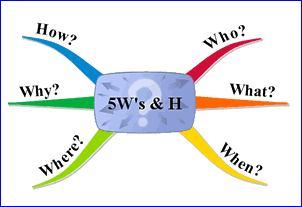 What do you do when you run out of ideas when you’re mind mapping? One way is to employ a simple questioning technique called “5Ws and H.”
What do you do when you run out of ideas when you’re mind mapping? One way is to employ a simple questioning technique called “5Ws and H.”
Whenever you’re brainstorming ideas and recording them in a mind map, there always comes a time when you hit the wall: Your brain, which was providing you with a deep wellspring of ideas and associations, suddenly goes dry. There is no more. What do you do then?
For most people, this is a sign that you have exhausted the easy ideas, which were residing close to the surface of your conscious mind. To dig deeper, to access the more creative ideas that lie at the boundaries of your conscious and subconscious mind, you need a catalyst to help draw them forth. One of the most reliable ways to do that is to utilize what poet Rudyard Kipling called his “six serving men” – open-ended questions based on these six words:
- Who?
- What?
- When?
- Why?
- Where?
- How?
Here is the full quote, from Kipling’s story “The Elephant’s Child”
I keep six honest serving-men:
(They taught me all I knew)
Their names are What and Where and When
And How and Why and Who.
In college, when I was studying journalism, these simple but powerful tools were called “5Ws and H,” and they were viewed as one of the keys that reporters can use to solicit all of the important information needed for a news story. Because they are open-ended questions, they aren’t easily answered with a “yes” or “no.” They invite more thinking and analysis. The Mycoted website, which contains an exhaustive list of creativity techniques, suggests the following 3 practical business uses for 5W and H:
- To generate data-gathering questions, during the early stages of problem solving when you are gathering data, the checklist can be useful either as an informal or systematic way of generating lists of question that you can try to find answers for.
- To generate idea-provoking questions, Whilst brainstorming, brainwriting or some other such similar technique, the checklist could be used as a source of thought provoking questions to help build on existing ideas.
- To generate criteria, the checklist could help in generating criteria for evaluating options.
Using 5Ws and H with mind mapping
5Ws and H are also quite useful to help you to ensure that your mind map contains all of the important details that it should. Whether you actually place these words on a branch, as I’ve done in the mind map above left, or simply use them as a mental trigger to help jump-start your creative mind, the “5 serving men” can help you to produce more thorough mind maps and better results. The key is to capture what you learn by asking these questions in your mind map.
The question “why?” can be quite fruitful. If you ask “why?” repeatedly, you will often discover new insights and ideas, says creativity expert Gerald Haman. For example, consider this series of “why” questions, and how they help us to uncover the root cause of a business problem. You can keep asking the same question, drilling down deeper into the nature of a problem or challenge. In effect, they help us to deconstruct it. The hierarchical nature of a mind map makes it easy for us to capture these successive layers of information, knowledge and ideas, so we can visually see the sequence of causes and effects.
The lesson is simple: The next time you get stuck when you’re developing a mind map, call forth your “six serving men” to help you to flesh out its details!

Leave a Reply